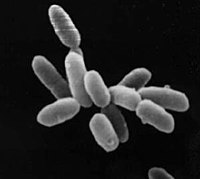
Photo from wikipedia
How well can ecological strategies of bacteria and archaea be characterized via quantitative traits? Bacteria with larger genome size are more versatile. They can transport and metabolise a wider range… Click to show full abstract
How well can ecological strategies of bacteria and archaea be characterized via quantitative traits? Bacteria with larger genome size are more versatile. They can transport and metabolise a wider range of substrates. More of their genome is engaged in signal detection and response, indicating they benefit from different resources at different times or under different conditions. Across cultured species aerobes were shown to average ca 35% larger genomes than anaerobes, after accounting for the previously-known decline in genome size with temperature. Aerobic habitats might well present opportunities and challenges that vary through time more than anaerobic habitats. Sy nt he si s A recent compilation of traits across culturable species of bacteria and archaea allows relationships to be quantified between genome size and other traits and habitat. Cell morphology, size, motility, sporulation and doubling time were not strongly correlated with genome size. Aerobic species averaged ca 35% larger genomes than anaerobic, adjusted for growth temperature. Aerobes had a similar mix of gene functions compared to anaerobes of the same genome size. Shifting proportions of aerobes to anaerobes accounted for about half of previously-known differences in mean genome size between habitats. One possible factor in these results could be if effective population sizes are larger for aerobes, reducing the potential for gene loss via genetic drift. Larger genomes also confer versatility. They can transport and metabolise a wider range of substrates. More of their genome is engaged in signal detection and response, indicating they benefit from different resources at different times or under different condition. Aerobic habitats might well present opportunities and challenges that vary through time more than anaerobic habitats. The genome size trait-dimension contributes a useful quantitative descriptor for ecological strategies.
Journal Title: Oikos
Year Published: 2021
Link to full text (if available)
Share on Social Media: Sign Up to like & get
recommendations!